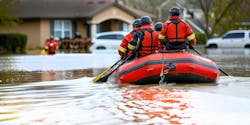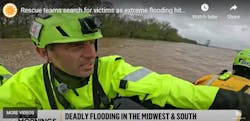Spike in Helicopter Hiker Rescues Straining CA Fire Agency
By Sara Cardine
Source Daily Pilot, Costa Mesa, Calif.
With helicopter rescues from May to July up 225% from the same time period the two years prior — and with Labor Day weekend fast approaching — Orange County’s first responders are asking residents to be prepared before they hit the trails.
Sheriff Don Barnes on Wednesday joined Orange County Fire Authority Chief Brian Fennessy and others in a news conference to convey the dangers of dehydration, improper attire and poor planning when recreating in remote wildland areas.
The shuttering of indoor gyms during the coronavirus pandemic has caused more people to exercise on the county’s trails, Barnes said. Crowds, combined with excessive heat, have caused a record number of search and rescue calls.
“The resources of both agencies are not limitless,” he warned. “This level of call volume may not be sustainable.”
In 2018, first responders conducted 36 rescues between May and July — last year, 37 requests for service were made during the same time period. By comparison, this year helicopter crews have been called to assist residents 117 times.
“We’ve seen an alarming increase in calls for help from people in remote areas who would not have needed to be rescued by a helicopter if they’d been more prepared,” he said. “Some simply wanted water or didn’t want to walk back from their hike.
“This takes away from our fire responses,” Fennessy continued. “When the sheriff’s helicopter or fire helicopter is out rescuing or providing services to people who didn’t prepare … that’s an impact to fire response.”
Orange County Sheriff’s Dep. Drew McMillan, a paramedic who copilots a UH-1H “Huey” helicopter, said many rescues could have been prevented with proper planning. He offered the following tips for people thinking of going out during current high temperatures:
Tell somebody where you’re going and when you’ll be back. That way they’ll know when to call for emergency response.
Look for trail markers and names, as well as landmarks you can describe to first responders searching for you, so they can pinpoint your exact location.
If an air crew is looking for you, make your presence known by standing in the open and waving your arms wide so you can be seen.
Hydrate, hydrate, hydrate. “If you think it’s enough, it’s probably not enough,” McMillan advised. “By the time you feel thirsty, your body is already dehydrated, and it could be too late.”
Wear bright colored clothing that would be visible from a distance. Aim for orange or blue, which stand out in a green or brownish landscape.
In a group, dedicate at least one cellphone for only emergency calls. If your cellphone battery dies during a rescue, you’ll lose contact with first responders.
OCFA firefighter Dan Dufrene said since crew members are trained to protect lives over property, responding to a rescue call takes precedence over fighting a vegetation fire.
“If you’re unprepared and you’re out, and you didn’t bring appropriate water … and we respond out to you, you could be pulling us away from a vegetation fire that could cause folks to lose their homes,” Dufrene said. “Please understand that your actions could have a larger impact than just yourself.”
———
©2020 the Daily Pilot (Costa Mesa, Calif.)
Visit the Daily Pilot (Costa Mesa, Calif.) at www.dailypilot.com
Distributed by Tribune Content Agency, LLC.






